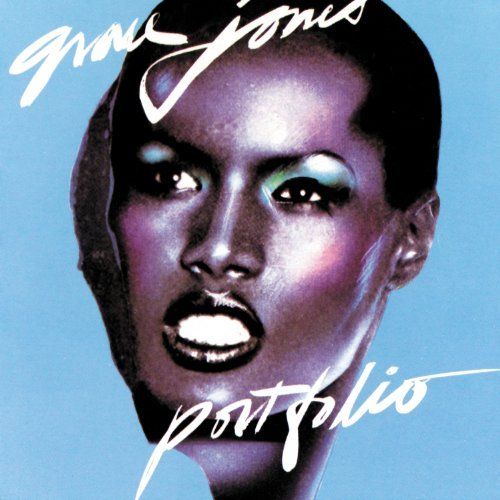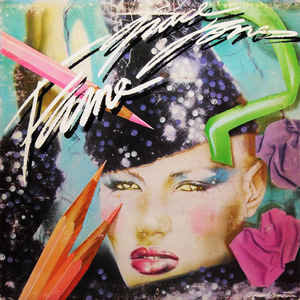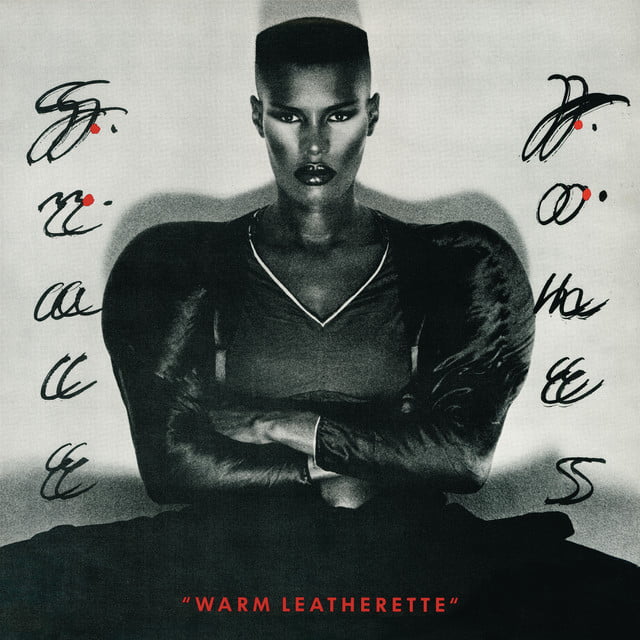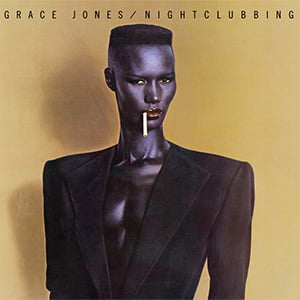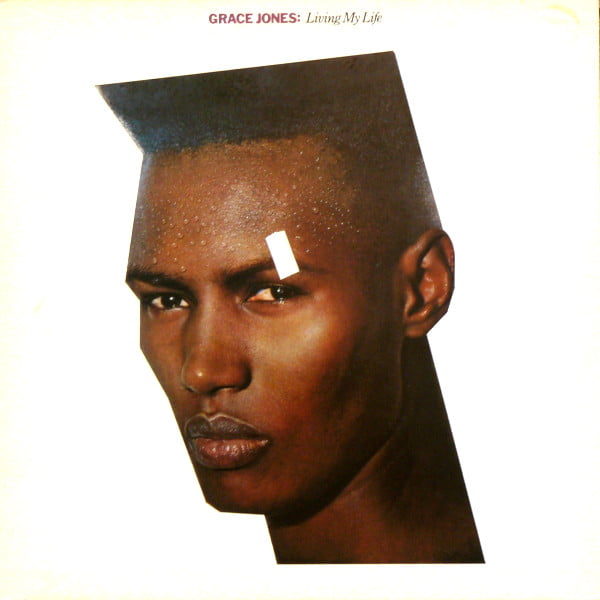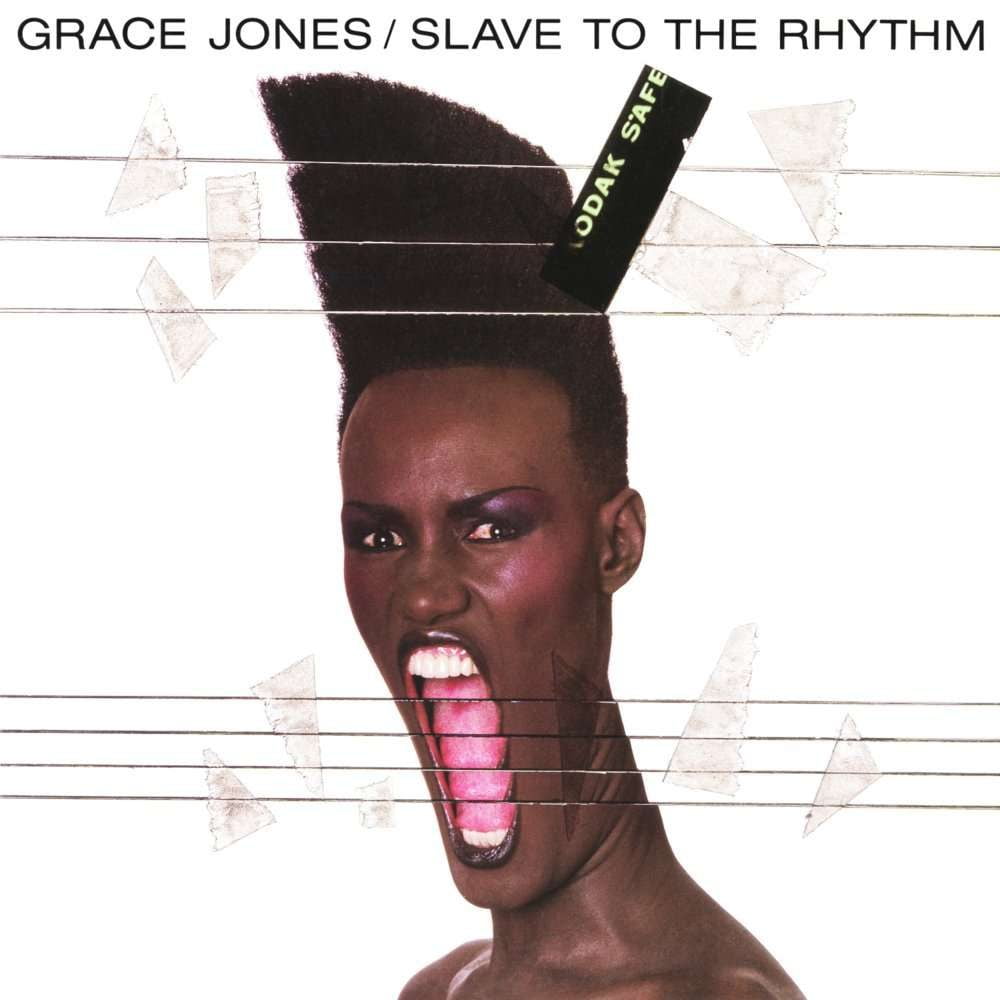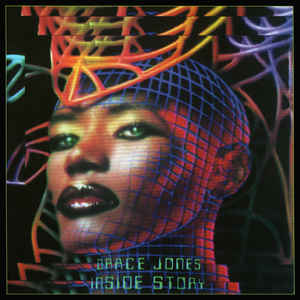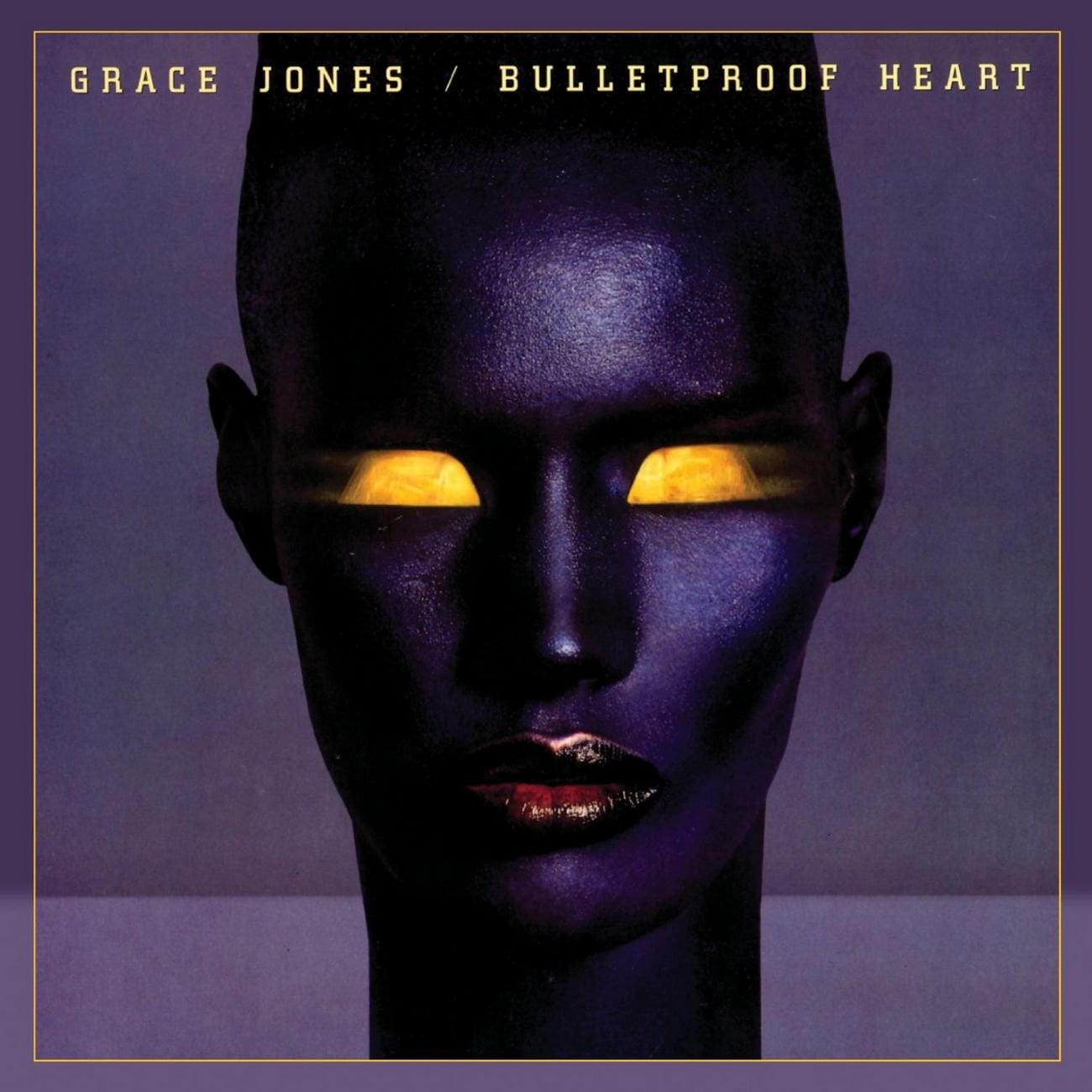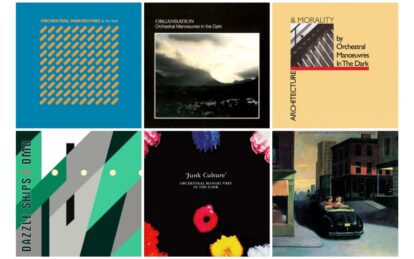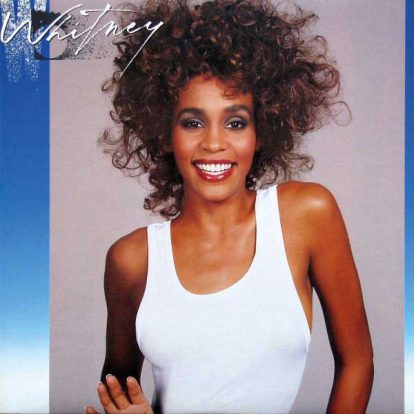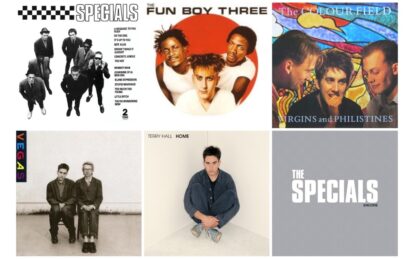Three distinct phases mark the the albums of Grace Jones – disco, reggae and dub excursions followed by all-out commercial pop. She’s recently been set the task of curating London’s annual Meltdown festival, and from closely examining her eclectic musical journey, we can definitely see why…
Portfolio
Producer Tom Moulton
1977
Chart Position
UK – and US No.109
For those that came to Grace Jones’ work via the sparse dub of Warm Leatherette or slinky electro funk of Pull Up To The Bumper, hearing her emote on a song from the Annie musical on her debut will come as something of a jolt.
Her 1977 solo album Portfolio is the first in a disco trilogy of long-players made with producer Tom Moulton. As a doyenne of New York and Parisian catwalks, as well as being a key scenester at the Big Apple’s now-legendary Studio 54 nightclub, in retrospect Jones’ first incarnation makes perfect sense.
However, she’s still to develop the formidable alien persona that she’d mine to such great effect throughout the 80s.
Her debut single I Need A Man was originally released by small French label Orfeus in 1975, while Jones was still working as a fashion model. It made little impact on the charts until it was remixed and released via the Beam Junction label, when it made it to No.1 in the US on the Billboard dance chart.
Recorded at the legendary Sigma Sound Studios that birthed the string- and horn-infused Philadelphia Soul movement, Jones hooked up with Moulton – the father of the extended disco mix (see Gloria Gaynor’s 19-minute suite on Never Can Say Goodbye in 1975). Moulton is also credited with inventing the concept of the disco breakdown and the popularisation of the 12″ single format.
The producer repeats the extended medley concept for Portfolio with Side One comprising a continuous 18-minute mix of covers, from Stephen Sondheim’s Send In The Clowns, Marvin Hamlisch and Edward Kleban’s What I Did For Love from A Chorus Line and, most extraordinary of all, an epic take on Tomorrow from Annie, at the time a brand new hit on Broadway.
Over the course of her career, Jones became expert in deconstructing songs and interpreting them in radical new ways, but these first recordings are played totally straight.
Her vocals are impressively polished on Send In The Clowns and, while it does outstay its welcome somewhat, her perky rendition of Tomorrow is really rather cute. Not a word that often springs to mind about the reliably feisty Ms Jones.
The album’s centrepiece is the acoustic guitar-driven version of Edith Piaf’s signature song La Vie En Rose – it remains a regular in Grace’s gig setlists to this day. Her first hit in Europe, it’s the best example of Moulton capturing the singer’s remarkable charisma on this debut album.
Sorry, her co-write with Pierre Papadiamandis, is a capable mid-paced discofied ballad, while Moulton does a decent job of amping up the drama in That’s The Trouble by adding swirling strings and stabbing brass.
As a vehicle for Jones’ one-off talent, Portfolio, as its title suggests, was an intriguing introductory calling card. Her love affair with the dancefloor – in all its forms – would be a long-held one and her persona as disco’s quirkiest diva began here. If showtunes done the Grace way is your thing, step right this way.
Read more: Top 40 New Romantic songs
Read more: Soft Cell interview
 Fame
Fame
Producer Tom Moulton
1978
Chart Position
UK – and US No.97
While Portfolio hardly set the world’s charts alight, Island Records were convinced that they were onto something with Jones’ solo career. Once again, Grace reunited with Tom Moulton at Sigma Sound for a hastily-arranged follow-up.
Essentially retracing the same template as her debut, Side One of Fame also comprises an extended disco medley. Pride positively gallops along with its funky guitar, bongos, sinewy bass and plentiful horn section.
The grandstand moment for Fame, though, is the striking seven-minute reworking of jazz standard Autumn Leaves. Like the original, it is sung entirely in French but was proof of Grace’s Europhile instincts and an ability to think outside the box of the conventional pop performer.
The high-kicking All On A Summer’s Night finds Jones cooing of the joy of new love and giving Barry Manilow a run for his money on Am I Ever Gonna Fall In Love In New York City.
The album was a hit on the North American club scene and further built on her following among gay fans. Mainstream fame was now on the horizon.
 Muse
Muse
Producer
Tom Moulton
1979
Chart Position
UK – and US No.156
By 1979, the Disco Sucks movement was in full force, marking the end of the road for numerous artists associated with the genre. With Jones behind the curve for once, and continuing in almost identical fashion to her previous two albums, she keenly felt the brunt of the disco backlash.
Unsurprisingly, Muse was both her final disco album and last collaboration with Tom Moulton. Taking the ‘if it ain’t broke, don’t fix it’ approach here was a mistake. Muse was ignored by the record-buying public and, in some quarters, has now been labelled Jones’ ‘lost’ album.
Her flirtation with dangerous sexuality rises to the surface on Suffer – an odd duet with Icelandic keyboardist Thor Baldursson with a decidedly S&M flavour.
Jimmy Williams, whose bass playing was a highlight of Fame, returns here and livens up the likes of straight-up floorfiller Repentance (Forgive Me).
Muse shines in its most unexpected moments, such as the testifying gospel of seven-minute epic Saved and organic funk of Atlantic City Gambler.
But Jones had rinsed disco for all it was worth. It was now time for her to move on and investigate new musical directions, or be left behind altogether.
Warm Leatherette
Producers Chris Blackwell and Alex Sadkin
1980
Chart Position
UK No.45 US No.132
Out went the disco session men to be replaced by the Compass Point All Stars, a genius collective gathered by Island Records’ Chris Blackwell around the nucleus of Jamaican rhythm section legends Sly Dunbar and Robbie Shakespeare.
Warm Leatherette was a remarkable reinvention for Jones that kicked off a run of critically-acclaimed albums embracing new wave, art rock, reggae, dub and electronica.
She brings an almost Kraftwerk-like robotic feel to the verses of an uncompromising art-rock cover of Daniel Miller’s Warm Leatherette under his moniker of The Normal which ended up being the album’s title cut: “Warm leatherette melts, On your burning flesh, You can see your reflection, On the luminescent dash.”
Its deliberately repetitive coda underlines this new reinvention as an otherworldly alien persona. It’s as far a cry from the crowd-pleasing disco of her previous LP trilogy as you can get.
When Warm Leatherette was released as a 7″ single, it was backed with an equally extraordinary cover of Joy Division’s She’s Lost Control. Jones was beginning to establish herself as a remarkable interpreter of other people’s work.
Edgier than the slightly more laid-back Pretenders original, which was included on the band’s eponymous debut album the same year, Private Life boasts some brilliantly detailed production with its multi-layered ticking percussion and rimshots.
The song’s writer Chrissie Hynde commented: “When I first heard Grace’s version, I thought ‘Now that’s how it’s supposed to sound!’ In fact, it was one of the high points of my career – what with Sly and Robbie being the masters, and Grace Jones with her scorching delivery.”
As with her Pretenders refit, Jones speeds up her take on Roxy Music’s Love Is A Drug, giving it a punchier, more wired feel. Bryan Ferry’s relaxed delivery is excised for something anxious, twitchy and pulsating.
Against such heavyweight competition, the jaunty Jones original A Rolling Stone feels like a tonal shift but it’s
a nice palette cleanser for the darker material elsewhere.
A radical reboot of the old Marvelettes’ Motown number The Hunter Gets Captured By The Game, written by Smokey Robinson, is an inspired choice. It’s totally unrecognisable from the original – Massive Attack would also revisit the track with Tracey Thorn for the Batman Forever soundtrack, no doubt using the Jones version as
their template.
Jones then makes it abundantly clear that she is repositioning herself as a take-no-prisoners ball buster by including the All Star’s guitarist Barry Reynold’s original song Bullshit. Icy synths on this track lay behind Reynolds’ gnarly overdriven shards of guitar.
Her cover of Tom Petty’s Breakdown is surprisingly faithful, but then again why mess with such economical perfection? Closing the album, the inclusion of French language Pars felt like the only nod to Jones’ past recorded work.
Nightclubbing
Producers Chris Blackwell and Alex Sadkin
1981
Chart Position
UK No.35 and US No.32
The peak of Jones’ Compass Point sessions, her fifth studio album is widely considered her greatest solo long-player, a perfectly realised artistic version that fully established her androgynous persona.
Throughout her time working in Barbados, her studio output was characterised by an atmosphere of almost intuitive efficiency – “If Grace or the group hadn’t nailed a song by the third take, it was dropped and they’d move on to the next number,” explained producer Chris Blackwell.
Once more melding experimentalism with dub, Jones channels her Jamaican influences, although the new wave, art-pop and synth-pop inflections drag this far away from its original sources. Jones makes the most of her toasting-style vocals on the dark ticking reggae of Walking In The Rain, a well-judged cover of a 1978 track by Australian band Flash And The Pan.
While that might have been an under-the-radar choice for many, Jones doesn’t duck a challenge elsewhere. She boldly takes on funky soul gem Use Me by Bill Withers, slowing down the groove and, in the process, reinventing the melody.
Equally audacious is grabbing the dark synth landscape of the Iggy Pop-covering title track, recasting the song as a spacious dub that’s heavy on the reverb.
I’ve Seen That Face Before (Libertango) boasts a wonderfully atmospheric creepy synth lead melody and is a reworking of Astor Piazzolla’s Libertango. It’s become a key song for Grace over the years, and yet more evidence of her lifelong love of French culture.
Her version of The Police’s Demolition Man once again mines her skill at delivering half-spoken, half-sung vocals.
If there is any sense that Jones is winging it as a vocalist, though, the subdued sophisti-pop soul of I’ve Done It Again will silence any doubters. Sade was no doubt taking notes.
In an album of many highlights, the sublime Pull Up To The Bumper still shines the brightest. Brilliantly produced and utterly irresistible, it’s a wonderful band performance, where the instantly recognisable elastic bassline, vehicular sound effects and simple guitar riff work perfectly together. Only lightweight filler track Feel Up drops the ball.
Her status as an experimental pop icon was now assured with this slow-burning masterwork.
Read more: Top 1981 singles
Living My Life
Produced Chris Blackwell and Alex Sadkin
1982
Chart Position
UK No.15 and US No.86
Bolstered by the critical and commercial success of Nightclubbing, the final instalment in Jones’ Bahamian trilogy finds her asserting herself as a songwriter in her own right. All but one of the songs – an ambitious seven-minute cover of The Apple Stretching from Broadway musical Waltz Of The Stork – are original compositions.
Jones penned the reggaefied synth-pop opener My Jamaican Guy alone, while the remaining six tracks are all co-writes. Nipple To The Bottle was worked up with drummer Sly Dunbar, with a further four tracks the result of a collaboration with guitarist Barry Reynolds.
Pick of the bunch of these are the wiry James Brown-influenced electro funk of Cry Now, Laugh Later and glacial synth-pop closer Unlimited Capacity For Love.
Grace tries sophisticated smooth soul on for size with Inspiration and worthy of seeking out for its ‘what the fuck?’ factor alone is a cover of Johnny Cash’s Ring Of Fire. Left off Living My Life, you can find it on the Compass Point Sessions compilation.
While nothing can touch the imperious original, the sheer chutzpah of Jones attempting it in the first place is to be applauded.
Read more: Top 40 Pet Shop Boys songs
Slave To The Rhythm
Producer Trevor Horn
1985
Chart Position
UK No.12 and US No.73
After her ground-breaking Compass Point trilogy, Jones took a break from making albums for three years, preferring to concentrate instead on acting (she appeared in Conan The Barbarian with Arnold Schwarzenegger and, most famously, as Bond villain May Day in A View To A Kill).
By now, after her Hollywood excursions and the odd controversial chat show appearance or two (Russell Harty received a slapping live on the BBC when he failed to pay enough attention to the star), Jones’ larger-than-life persona had become more famous than her music.
For her seventh studio album, Grace turned to producer Trevor Horn for another radical reinvention. Befitting her stature, it was an elaborate, over-the-top concept record that mined her charisma for all it was worth.
Originally intended for Frankie Goes To Hollywood as a follow-up to Relax, Slave To The Rhythm features eight radical interpretations of one central musical conceit. These are interspersed by delightfully pretentious voiceovers by actor Ian McShane, where he recites passages from Jean-Paul Goude’s Grace Jones biography Jungle Fever, plus interview segments by journalists Paul Morley and Paul Cooke.
There’s an operatic grandeur to opener Jones The Rhythm and the album’s a showcase for Horn’s skill as a producer, essentially making a 43-minute LP out of one central chord progression and a handful of lyrics.
While it could sound like an overstretched 12″ remix in the wrong hands, there’s enough diversity and imagination at play here to pull it off. The Frog And The Princess finds McShane telling the story of Goud’s tempestuous relationship with Jones and the experimental Operattack takes the concept of deconstruction to the extreme.
Confusingly, the title track is not the single you’ll be aware of, which is included here in an extended form as Ladies And Gentleman: Miss Grace Jones. What a fantastic slice of percussive 80s funk pop that is.
An extraordinary exercise in myth-making. While you get the feeling this was as much a vehicle for Horn as it was for Jones, it’s none the worse for it.
Read more: My life in vinyl – Trevor Horn
Inside Story
Producers Nile Rodgers and Grace Jones
1986
Chart Position
UK No.61 and US No.81
It only takes a few seconds of opener I’m Not Perfect (But I’m Perfect For You) to hear the unmistakable input of producer Nile Rodgers; Simon Le Bon could take over on lead vocals and it would fit perfectly on Duran Duran’s Notorious LP, which Rodgers worked on the same year.
Jones co-produced the album and predictably enough, there were plenty of fireworks behind the mixing desk as she clashed with Nile over the direction of the music.
Rodgers’ pop instinct naturally draws the album into a more straightforward commercial territory – from the upbeat synth-led Chan Hitchhikes To Shanghai to the sultry soul of Victor Should Have Been A Jazz Musician. Crush merely seems like getting some value out of a rhyming dictionary, while the rather slight Hollywood Liar is saved by Grace’s committed vocal performance. Meanwhile, Rodgers smooths off all of her rough edges for the easygoing Barefoot In Beverly Hills.
Too often, Inside Story feels like two mismatched personalities cancelling each other out. It remains a personal favourite of Jones, though.
In her 2015 autobiography, I’ll Never Write My Memoirs, she explained: “Nile’s ear was different from mine, and he was responding to his idea of me, and it was an American Nile production, with all that entails, but I think it is beautiful. There were other ways of doing that material, but I like how it ended up. I don’t listen to all my records, but I play that one a lot.”
Read more: Nile Rodgers interview
Read more: Top 20 girlband singles of the 80s
Bulletproof Heart
Producers Grace Jones, Chris Stanley, C+C Music Factory, Jonathan Elias
1989
Grace’s 80s ended with a damp squib rather than a bang, with a clear sense on Bulletproof Heart that she’s chasing trends rather than setting them.
Co-writing the bulk of the album with her first husband, Chris Stanley, it continues the commercial approach of Inside Story and attempts to grab a bit of the action of the then-current fashion of beat-heavy electronic R&B. Clivillés and Cole of C+C Music Factory, the hot production duo of the time, deliver the best moments, including Love On Top Of Love, one of only two singles released on the LP.
Driving Satisfaction piles on the motoring metaphors for an opener that returns to the double entendres of Pull Up To The Bumper, while Kicked Around is another trademark Jones anthem of defiance.
Crack Attack, a rare attempt at social commentary featuring a guest rap from Freedom, is one of few highlights but the plodding Paper Plan is more typical of an album that rarely catches fire. The title track’s resemblance to Michael Jackson’s The Way You Make Me Feel gives more weight to the argument that Jones and her team were, for the most part, running on empty.
Her flair for experimentation is glimpsed on the laid-back groove of On My Way and there’s her regular dip into French music on a closing cover of Amado Mio from the Rita Heyworth movie Gilda but it’s slim pickings elsewhere.
Hurricane
Producers Ivor Guest, Grace Jones, Antony Genn and Bruce Woolley
2008
Chart Position
UK No.42
After a recording gap of almost 20 years, Jones’ 10th studio album was an unexpected triumph, underlining her iconic status but also bringing her sound bang up to date. After Bulletproof Heart, the singer had vowed never to record a new album again but was convinced to have another crack by producer Ivor Guest.
Highlights abound, from the brilliant expansive autobiographical pop of Williams’ Blood co-written with Wendy Melvoin and Lisa Coleman formerly of The Revolution, to the dark vampiric allure of Corporate Cannibal, which lambasts capitalist greed while mining the same guitar/electro mash-up as Massive Attack’s brooding Inertia Creeps.
Jones returns to authentic skanking reggae on Well Well Well and the title track (co-written with Tricky, who turns in a sinister performance on whispering backing vocals) asserts her force-of-nature persona. The sweeping Devil In My Life is a dramatic end to her recording career to date.
Also worthy of investigation is the full-scale remix version of the album, Hurricane Dub, which features expansive reimaginings by original producer Guest.
Read more: Top 20 cover versions of the 80s
Classic Pop may earn commission from the links on this page, but we only feature products we think you will enjoy.

